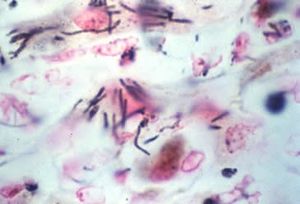Clostridium piliforme: Difference between revisions
Sethlitvin (talk | contribs) |
Sethlitvin (talk | contribs) |
||
| Line 6: | Line 6: | ||
''Clostridium piliforme'', formerly known as ''Bacillus piliformis'', is a large (8-40 mm) gram negative filamentous rod shaped bacteria. It is a member of the family ''Clostridiaceae''. It is an intracellular, spore forming, obligate anaerobe. ''C. piliforme'' is pleomorphic and motile in nature.[ | ''Clostridium piliforme'', formerly known as ''Bacillus piliformis'', is a large (8-40 mm) gram negative filamentous rod shaped bacteria. It is a member of the family ''Clostridiaceae''. It is an intracellular, spore forming, obligate anaerobe. ''C. piliforme'' is pleomorphic and motile in nature.<ref>[http://www.ncbi.nlm.nih.gov/pmc/articles/PMC2104098/pdf/jmedres00030-0118.pdf] | ||
Revision as of 08:12, 21 November 2011
Wiki In Progress Ex. [[]]
Characteristics of the symbiont/pathogen

What kind of microbe is it (eg Cell morphology, shape, phylogenetic classification)? Is its genome sequenced, and if so, how big is the genome?
Clostridium piliforme, formerly known as Bacillus piliformis, is a large (8-40 mm) gram negative filamentous rod shaped bacteria. It is a member of the family Clostridiaceae. It is an intracellular, spore forming, obligate anaerobe. C. piliforme is pleomorphic and motile in nature.<ref>[1]
Due to normal staining procedures producing weak results, confirmation of the bacteria is usually done with silver impregnation or Giemsa stains. The bacteria cannot be grown in a cell free environment but can be grown in hen eggs and some mammalian cell cultures.
Characteristics of the host
What host/s is/are involved? Is there host specificity? Are there secondary reservoirs?
C. piliforme can infect a variety of hosts but is most commonly found in rodents. It can infect hosts either through the inhalation of spores or via an oral fecal route, usually through the consumption of the feces of an already infected animal.
Host-Symbiont Interaction
What kind of interaction do host and symbiont have? How is the host affected by the relationship? How does the host acquire and transmit the symbiont? Is the interaction obligate or facultative?
Molecular Insights into the Symbiosis
Describe molecular/genetic studies on the symbiosis.
Ecological and Evolutionary Aspects
What is the evolutionary history of the interaction? Do particular environmental factors play a role in regulating the symbiosis?
Recent Discoveries
Describe two findings on the symbiosis published within the last two years.
References
[[2] Tyzzer EE. A fatal disease of the Japanese waltzing mouse caused by a spore-bearing bacillus (Bacillus piliformis, N. SP.) J Med Res 1917; 37:307-338.]
Edited by Seth Litvin, student of Grace Lim-Fong
This template is just a general guideline of how to design your site. You are not restricted to this format, so feel free to make changes to the headings and subheadings and to add or remove sections as appropriate.
